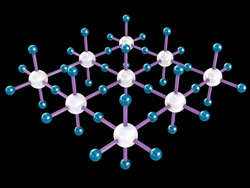Enhancing separation membrane selectivity
Gas separation via selectively permeable membranes is used to recover hydrogen gas, to remove carbon dioxide (CO2) and to dehumidify air, to name only a few uses. The ‘Multicomponent nanostructured materials for separation membranes’ (Compose) project sought to develop novel nano-structured materials with highly selective permeability to regulate the flux of substances. Investigators focused on two classes of nano-structured materials, namely hybrid materials and self-organised materials. While selective gas separation using polymeric membranes is a rapidly growing branch of membrane technology, the existing materials are often inadequate as permeability is sacrificed at the expense of selectivity and vice versa. Hybrid materials (consisting of both organic and inorganic components), such as mixed matrix membranes (MMMs) formed by incorporating inorganic particles into organic polymeric structures, show great potential for improving gas separation properties. Self-organised supramolecular co-polymers, on the other hand, self assemble based on chemical and physical properties to form thin films much like the cellular membrane that selectively separates the internal from the external cellular environment. Understanding and exploiting nature’s organisation holds promise for a completely new paradigm in separation membrane technology. Investigators manufactured various types of MMMs with promising results. Membranes composed of nanoparticles (NPs) incorporated into polymers including polyacetylenes, cellulose-based polymers and polydimethylsiloxane rubber exhibited excellent permeability with significantly enhanced selectivity. Researchers also employed a combination of self assembly and classical membrane formation to produce a membrane with a highly ordered self-assembled top layer over a porous non-ordered support layer. Compose have developed new nano-structured materials and manufactured them into separation membranes, enhancing both permeability and selectivity. Commercial availability of the membranes has the potential to enhance selective transport and separation in a variety of fields with positive effects on European industrial and energy applications as well as CO2 sequestration and global warming.







